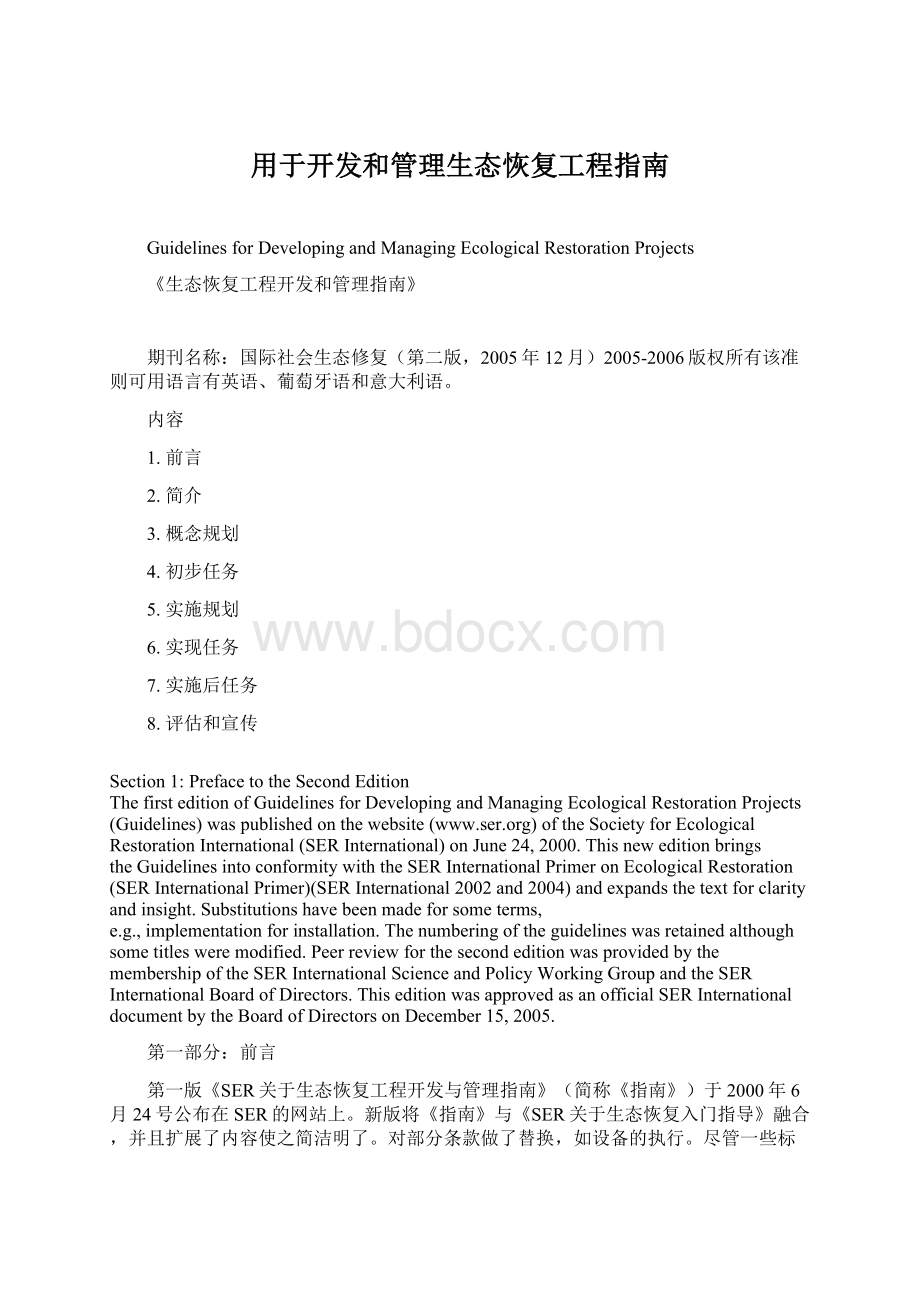用于开发和管理生态恢复工程指南.docx
《用于开发和管理生态恢复工程指南.docx》由会员分享,可在线阅读,更多相关《用于开发和管理生态恢复工程指南.docx(25页珍藏版)》请在冰豆网上搜索。

用于开发和管理生态恢复工程指南
GuidelinesforDevelopingandManagingEcologicalRestorationProjects
《生态恢复工程开发和管理指南》
期刊名称:
国际社会生态修复(第二版,2005年12月)2005-2006版权所有该准则可用语言有英语、葡萄牙语和意大利语。
内容
1.前言
2.简介
3.概念规划
4.初步任务
5.实施规划
6.实现任务
7.实施后任务
8.评估和宣传
Section1:
PrefacetotheSecondEdition
Thefirsteditionof GuidelinesforDevelopingandManagingEcologicalRestorationProjects(Guidelines) waspublishedonthewebsite(www.ser.org)oftheSocietyforEcologicalRestorationInternational(SERInternational)onJune24,2000.Thisneweditionbringsthe Guidelines intoconformitywiththe SERInternationalPrimeronEcologicalRestoration(SERInternationalPrimer)(SERInternational2002and2004)andexpandsthetextforclarityandinsight.Substitutionshavebeenmadeforsometerms,e.g., implementation for installation.Thenumberingoftheguidelineswasretainedalthoughsometitlesweremodified.PeerreviewforthesecondeditionwasprovidedbythemembershipoftheSERInternationalScienceandPolicyWorkingGroup andtheSERInternationalBoardofDirectors.ThiseditionwasapprovedasanofficialSERInternationaldocumentbytheBoardofDirectorsonDecember15,2005.
第一部分:
前言
第一版《SER关于生态恢复工程开发与管理指南》(简称《指南》)于2000年6月24号公布在SER的网站上。
新版将《指南》与《SER关于生态恢复入门指导》融合,并且扩展了内容使之简洁明了。
对部分条款做了替换,如设备的执行。
尽管一些标题有所改动,但仍保留了指导方针编号方式。
SER的科学与政策工作组以及董事会的成员对第二版做了评论。
2005年11月15日,董事会将本版作为SER的官方文件。
Section2:
Introduction
ThisdocumentdescribestheproceduresforconductingecologicalrestorationinaccordwiththenormsofthedisciplinethatwereestablishedintheSERInternationalPrimer(SER2002and2004).Eachprocedureisstatedintermsofaguidelinethatleadsrestorationpractitionersandprojectmanagersstepwisethroughtheprocessofecologicalrestoration.Adherencetothese51guidelineswillreduceerrorsofomissionandcommissionthatcompromiseprojectqualityandeffectiveness.Theguidelinesareapplicabletotherestoration*ofanyecosystem—terrestrialoraquatic—thatisattemptedanywhereintheworldandunderanyauspices,includingpublicworksprojects,environmentalstewardshipprograms,mitigationprojects,privatelandinitiatives,etc.UsersoftheGuidelinesareadvisedtobecomefamiliarwiththeSERInternationalPrimerinadvanceandrefertoitfordefinitionsoftermsanddiscussionsofconcepts.Designissuesandthedetailsforplanningandimplementingrestorationprojectsliebeyondthescopeoftheseguidelines.Weleavesuchcomplexitiestotheauthorsofmanualsandthepresentersofworkshopswhoaddressthesetopics.
第二部分:
引言
Ecologicalrestorationistheprocessofassistingtherecoveryofanecosystemthathasbeendegraded,damaged,ordestroyed.Itisanintentionalactivitythatinitiatesoracceleratesecosystemrecoverywithrespecttoitshealth(functionalprocesses),integrity(speciescompositionandcommunitystructure),andsustainability(resistancetodisturbanceandresilience).Restorationensuresabioticsupportfromthephysicalenvironment,suitableflowsandexchangesoforganismsandmaterialswiththesurroundinglandscape,andthereestablishmentofculturalinteractionsuponwhichtheintegrityofsomeecosystemsdepends.Restorationattemptstoreturnanecosystemtoitshistorictrajectory,i.e.,toastatethatresemblesaknownpriorstateortoanotherstatethatcouldbeexpectedtodevelopnaturallywithintheboundsofthehistorictrajectory.Therestoredecosystemmaynotnecessarilyrecoveritsformerstate,sincecontemporaryconstraintsandconditionscancauseittodevelopalonganalteredtrajectory.
InaccordwiththeSERInternationalPrimer,theseGuidelinesassumethatecologicalrestorationisaccomplishedoncetheassistanceofarestorationpractitionerisnolongerneededtoensurelong-termecosystemsustainability.However,ecosystemmanagementmayberequiredtopreventrecurrentdegradationofrestoredecosystemsonaccountofalterationsintheenvironmentoranthropogenicchanges.Suchactivitiesareconsideredmanagementratherthanrestoration.Inotherwords,ecologicalrestorationmakesecosystemswholeagainandecologicalmanagementkeepsthemwhole.Correspondingly,somerestoredecosystemswillrequiremanagementintheformoftraditionalculturalpractices.Thisdistinctionbetweenrestorationandmanagement(includingculturalpractices)facilitatesresourceplanningandbudgeting,anditprotectsecologicalrestorationeffortsfrombeingheldliableforsubsequentinconsistenciesormisjudgmentinecosystemmanagement.
Theprojectguidelinesarenumberedforconvenience.Theydonotnecessarilyhavetobeinitiatedinnumericalorder,andsomemaybeaccomplishedconcurrently.Theguidelinesaregroupedintosixphasesofprojectwork:
conceptualplanning(includingfeasibilityassessments),preliminarytasks(uponwhichsubsequentplanningrelies),implementationplanning,projectimplementation,post-implementationtasks(monitoringandaftercare),andevaluationandpublicity.
Werecommendthatadiarybekeptforeachguidelinetodocumentprojectactivitiesastheyhappenandtorecordallrelevantinformationforeachguidelineasitisgenerated.Tabulardata,graphics,andancillarydocumentscanbeappended.NarrativesintheformofwrittenresponsestoGuidelines#1through#36collectivelycompriseacomprehensiveecologicalrestorationplanthatcanbefiledwithpublicagencies,fundinginstitutions,permittingauthorities,corporateoffices,andotherinterestedparties.Thenarrativesserveasthebasisforpreparingprogressreportsandapplicationsforcontinuingfinancialsupport.Theybecomeinvaluabletonewpractitionersandmanagementpersonnelwhoareassignedinmid-project.Whentheprojecthasbeencompleted,thenarrativescompriseathoroughandwellorganizedcasehistorywhichonlyneedseditingtogenerateafinalreportandtopreparearticlesforpublication.
* “Restoration”whenusedaloneinthisdocumentconnotes“ecologicalrestoration.”
本文件叙述了生态恢复实施的策略,使之符合立足于《SER入门指导》(SER2002and2004,www.ser.org)的训练规则。
每一步骤都在指南中规定了,引导修复工作者以及工程管理者的工作。
遵循这51条指导可以减少对工程质量和效果有危害的错误。
这些指南适合全世界需要保护的任何需恢复的陆生或水生生态系统,包括公共计划、环境服务项目、缓解项目、私有土地开发等。
《指南》的使用者要求提前熟悉《SER关于生态恢复入门指导》以及涉及条款的解释和概念性的讨论等内容。
设计内容、计划细节和生态恢复工程实施都列于《指南》的范围之内。
我们将这复杂的事情留给手册的起草者和选此题目的工作组负责人。
生态修复是促进那些已经退化、毁坏和消失的生态系统恢复的过程。
这是一个国际范围内的活动,着手或加快生态修复要考虑到他的健康(功能过程)、整体性(物种组成和群落结构)以及可持续性(对干扰的抵抗力和恢复力)。
生态恢复要确保物理环境的非生物支持、适当的流动、有机体的交换、周围景观的原材料以及生态系统整体性所依存的文化合作的重建。
生态修复试图恢复一个与历史上存在的相类似的生态系统,比如恢复到先前的状态或者是能自然发展到先前轨迹范围内的生态系统的状态。
恢复的生态系统没有必要恢复到先前的状态,因为当前的约束和环境能导致生态系统的发展出现变动。
与《SER入门指导》相一致,《指南》认为修复的生态系统一旦不需要恢复工作者支持就能长期的可持续的发展下去,生态恢复就完成了。
尽管如此,生态系统的管理仍需进行,以阻止经常发生的退化以及环境改变、人类活动对恢复的生态系统的损害。
生态系统的管理比恢复更重要。
换言之,生态恢复是再造一个生态系统而生态管理则是保持它整体性。
相对地一些恢复的生态系统需要以传统文化方式的管理。
修复与管理的区别减少了资源规划预算,他避免了在生态系统管理中出现的后续的矛盾或误判。
工程指南是少有的方便手册,工程计划没必要按其顺序来操作,有的可以同时完成。
他将工程过程分为六部分:
概念性规划(包括可行性评价)、前期工作、实施计划、项目实施、实施后期任务(监测和护理)、评价与宣传。
我们建议对发生的项目实施的事情记日记以及记录每一个指导条款改变的相关信息。
并附加一些数据表、图表、辅助文件。
对于那些提交到公共代理处、基金组织、许可机构、团体以及其他的相关的团体的综合的生态修复计划,要对指南的第1至36条条款做好书面文件。
这些文件为准备进展报告、资金支持提供基础,对于那些在项目过程中被指派的新工作者和管理者也变得有价值。
当项目结束了,这些文件就包括了整个实施过程的记录,用来编辑总结报告和准备出版。
第三部分:
概念性规划
Conceptualplanningidentifiestherestorationprojectsite,specifiesrestorationgoals,andprovidesrelevantbackgroundinformation.Conceptualplanningisconductedwhenrestorationappearstobeafeasibleoptionbutbeforeadecisionhasbeenmadetoexercisethatoption.Conceptualplanningprovidespreliminaryinformationsuchasobservationsfromsitereconnaissanceandperhapsafewrepresentativemeasurements.Detailed,systematicinventoriesofecosystempropertiesandthebiotaarenotincludedinthisphaseofactivity.WrittenresponsestoGuidelines#1through#16collectivelycomprisetheconceptualplanandbroadlycharacterizetheproposedrestorationproject.
概念性规划明确恢复工程地点,制定修复目标,提供相关的背景信息。
概念性规划来引导所选的计划的实践,这些选取的计划可行但还未决定。
概念性规划能提供最初的信息,如地形的观察和代表性的测量值。
详细系统的关于此生态系统的特征和生物信息则不包括在本期实践活动中。
对指南的第1至16条条款所规定的,将提出的恢复计划的概念性规划和大体上的特征做好书面记录。
1.Identifytheprojectsitelocationanditsboundaries.Delineateprojectboundariesandportraythemasmaps,preferablygeneratedonasmall-scaleaerialphotographandalsoonsoilandtopographicmapsthatshowthewatershedandotheraspectsofthesurroundinglandscape.UseofGPS(GlobalPositioningSystem),landsurvey,orothermeasurementdevicesasappropriateisencouraged.
1.明确工程位置和界限。
描述工程界限,绘制地图,有可能的话做一些小范围的航片,以及从土地和地形上找出分水岭和其他周围景观的信息。
鼓励使用GPS、土地测量或者其他的测量装置。
2.Identifyownership.Givethenameandaddressofthelandowner(s).Ifanorganizationorinstitutionownsormanagesallorpartofthesite,givethenamesandtitlesofkeypersonnel.Notetheauspicesunderwhichtheprojectwillbeconducted—publicworks,environmentalstewardship,mitigation,etc.Ifthereismorethanoneowner,makesurethatallareinagreementwiththegoalsandmethodsproposedfortherestorationprogram.
2.明确所有权提供所有人的姓名和地址。
如果一个组织或机构对该地有全部或部分所有权或管理权,要提供主要人员的姓名。
记录项目实施下提供赞助的公共工作、环境服务、缓解等项目。
如果不只有一个所有人,要确保所有的所有人都同意提出的恢复项目的目标和方法。
3.Identifytheneedforecologicalrestoration.Tellwhathappenedatthesitethatprecipitatedtheneedforrestoration.Describetheimprovementsthatareanticipatedfollowingrestoration.Benefitsmaybeecological,economic,cultural,aesthetic,educational,andscientific.Ecologicalbenefitsmayamplifybiodiversity;improvefoodchainsupport,etc.Economicbenefitsarenaturalservices(alsocalledsocialservices)andproductsthatecosystemscontributetowardshumanwellbeingandeconomicsustainability.Ecosystemsinthisregardarerecognizedandvaluedasnaturalcapital.
3.明确生态恢复的需求。
弄清该地方发生的事以及恢复所需,预先对下一步的恢复计划的改进作描述。
利益可能是生态的、经济的、文化的、美学的、教育的和科学的。
生态价值有可能增强生物多样性,改善食物链的供应。
经济利益就是自然服务(也叫社会服务)和对人类健康和经济持续的产品。
这些生态系统是被公认的、有价值的天然资本。
Culturalimprovementsmayincludesocialperformanceandrituals,passiverecreation,andspiritualrenewal.Aestheticbenef